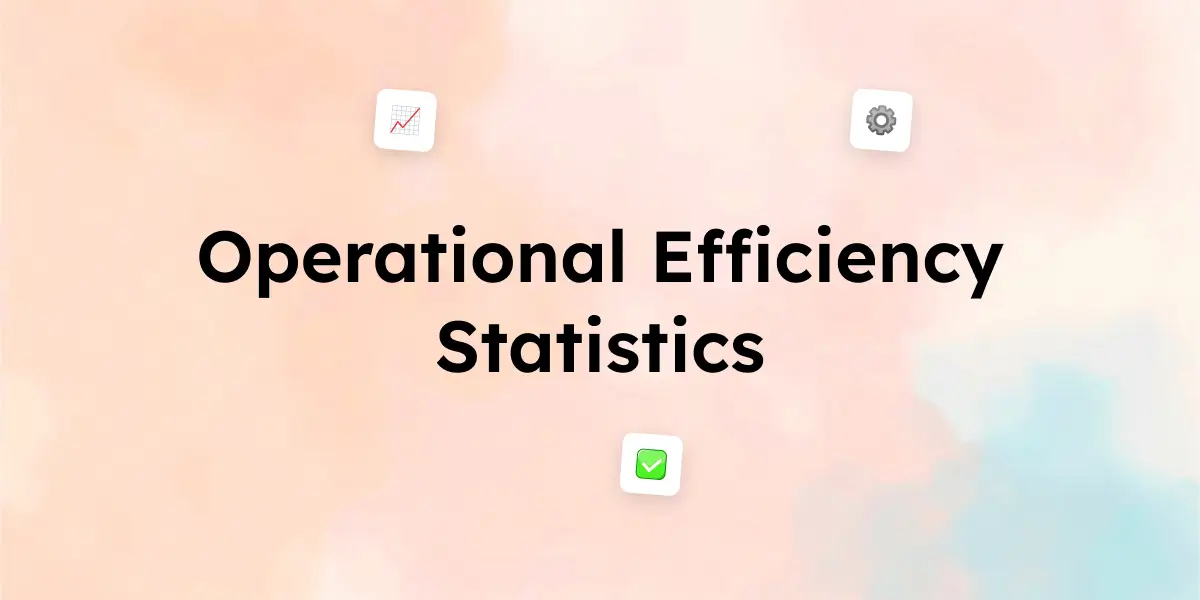In 2025, enterprises are doubling down on operational efficiency to stay competitive. With rising costs, evolving consumer expectations, and rapid technological advancements, businesses are leveraging automation, AI, cloud computing, and data analytics to streamline processes and boost productivity.
Why does this matter? Inefficient operations can cost enterprises millions of dollars in wasted resources, lost productivity, and poor decision-making. Research shows that companies investing in process optimization and digital transformation are outperforming their competitors and achieving higher profitability.
This article highlights 35 key operational efficiency statistics that define the business landscape in 2025, helping organizations make data-driven decisions to improve efficiency, reduce costs, and drive growth.
35 Operational Efficiency Statistics
1. The State of Operational Efficiency in 2025
- 78% of enterprises identify operational efficiency as a top priority in 2025.
- 60% of companies report increased investments in automation to enhance efficiency.
- 42% of enterprises believe inefficient processes cost them at least 10% of their annual revenue.
- 95% of business leaders say process optimization is crucial for long-term success.
- 67% of CEOs are prioritizing digital transformation to improve operational performance.
2. Automation and AI in Operational Efficiency
- 53% of enterprises use AI-driven automation to reduce manual work.
- Businesses implementing AI see an average 30% increase in efficiency.
- 70% of routine business tasks are expected to be automated by 2030.
- AI-powered chatbots reduce operational costs by $8 billion annually for enterprises.
- 89% of executives believe AI will help eliminate inefficiencies in the next five years.
3. Workforce Productivity and Remote Work
- 74% of companies report improved productivity with hybrid work models.
- Enterprises that allow flexible work see a 15% increase in employee efficiency.
- 68% of employees feel that automation helps them focus on higher-value tasks.
- Companies with strong remote work policies save an average of $11,000 per employee per year.
- 58% of organizations use performance-tracking software to measure operational efficiency.
4. Cost Savings and Waste Reduction
- Inefficient processes cost enterprises an estimated $3 trillion annually worldwide.
- 46% of businesses cut operational costs by at least 20% through automation.
- AI-driven supply chain optimizations lead to a 40% reduction in waste.
- 30% of business leaders believe poor data management slows down efficiency.
- Companies using predictive analytics reduce operational expenses by 25% on average.
5. Technology and Digital Transformation
- 69% of enterprises use cloud computing to improve operational agility.
- Cloud-based businesses experience a 21% lower downtime rate compared to on-premise solutions.
- 92% of IT leaders say digital transformation is necessary for operational success.
- 80% of companies have adopted IoT technology to streamline operations.
- Organizations leveraging big data analytics report a 26% boost in efficiency.
6. Customer Experience and Operational Efficiency
- 57% of consumers say they expect faster service due to automation.
- Companies that improve operational efficiency see a 25% increase in customer retention.
- 40% of businesses use AI to enhance customer service interactions.
- 72% of customers prefer self-service options for faster resolutions.
- Organizations focusing on customer experience are 1.5x more likely to outperform competitors.
7. The Future of Operational Efficiency
- By 2030, operational efficiency improvements could add $15 trillion to global GDP.
- 68% of enterprises plan to increase their automation investments by 2026.
- 90% of business leaders expect AI-driven decision-making to be standard by 2028.
- Organizations that invest in efficiency initiatives see a 4.5x return on investment.
- Enterprises that fail to optimize processes risk losing 20-30% of their revenue due to inefficiencies.
Conclusion
Operational efficiency is no longer just about cutting costs—it’s about building a resilient, agile, and high-performing organization. Enterprises that invest in AI-driven automation, workforce productivity tools, and data analytics are seeing significant improvements in revenue, customer satisfaction, and operational agility.
By staying ahead of these trends, businesses can reduce inefficiencies, optimize resources, and create a sustainable competitive advantage. The statistics in this article prove that 2025 is the year of digital transformation and process optimization—are you ready to embrace it?
What operational efficiency strategies is your company using in 2025? Share your thoughts in the comments!
Frequently Asked Questions (FAQs)
1. What is operational efficiency, and why is it important?
Operational efficiency refers to how well a company maximizes its resources—time, labor, and capital—while minimizing waste and costs. It’s crucial because inefficiencies can cost businesses up to 30% of their revenue, while efficient companies experience higher productivity and profitability.
2. How does AI improve operational efficiency?
AI automates repetitive tasks, analyzes large datasets for better decision-making, optimizes supply chains, and enhances customer service. Companies using AI report a 30% increase in efficiency and significant cost savings.
3. What industries benefit the most from operational efficiency improvements?
Industries like manufacturing, healthcare, retail, finance, and logistics benefit the most. For example, AI-powered supply chains reduce waste by 40%, and predictive analytics helps reduce operational expenses by 25%.
4. How can businesses measure operational efficiency?
Common key performance indicators (KPIs) include:
Revenue per employee (measuring workforce productivity)
Cost-to-revenue ratio (analyzing profitability)
Process cycle efficiency (identifying bottlenecks)
Customer satisfaction scores (ensuring quality service)
Sources :
McKinsey & Company
Deloitte
Gartner
Harvard Business Review (HBR)



